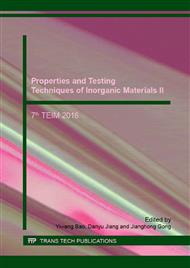[1]
Z.X. Song, K.W. Xu, H. Chen. The characterization of Zr-Si-N diffusion barrier films with different sputtering bias Voltage, Thin Solid Films. 468 (2004) 203-207.
DOI: 10.1016/j.tsf.2004.04.037
Google Scholar
[2]
A. Horling, L. Hultman, M. Oden, et al. Mechanical properties and machining performance of Ti1-xAlxN coated cutting tools, Surface and Coatings Technology. 191 (2005) 384-392.
DOI: 10.1016/j.surfcoat.2004.04.056
Google Scholar
[3]
T.S. Kumar, S.B. Prabu, G. Manivasagam, et al. Comparison of TiAlN, AlCrN, and AlCrN/TiAlN coatings for cutting-tool applications, International Journal of Minerals, Metallurgy and Materials. 21: 8 (2014) 796-805.
DOI: 10.1007/s12613-014-0973-y
Google Scholar
[4]
H. Zhang, S.W. Duo, X.M. Xu, et al. Impact of CrAlN coatings on oxidation behavior of K38G alloy at 800 and 900°C, Key Engineering Material. 591 (2014) 168-171.
DOI: 10.4028/www.scientific.net/kem.591.168
Google Scholar
[5]
S. Y. Tang, S. W. Hu, Y. Zhang, et al. Influence of TiN coating on products distribution for hydrocarbon fuelcracking under high temperature and pressure, Journal of Analytical and Applied Pyrolysis. 104 (2014) 197-203.
DOI: 10.1016/j.jaap.2014.03.003
Google Scholar
[6]
A. N. Wang, G. P. Yu, J. H. Huang. Fracture toughness measurement on TiN hard coatings using internal energy induced cracking, Surface and Coatings Technology. 239 (2014) 20-27.
DOI: 10.1016/j.surfcoat.2013.11.010
Google Scholar
[7]
A. Bahri, N. Guermazi, K. Elleuch, et al. Tribological performance of TiN coatings deposited on 304 L stainless steel used for olive-oil extraction, Wear. 342-343 (2015) 77–84.
DOI: 10.1016/j.wear.2015.08.012
Google Scholar
[8]
D. A. Colombo, M. D. Echeverría, R. C. Dommarco, et al. Influence of TiN coating thickness on the rolling contact fatigue resistance of austempered ductile iron, Wear. 350-351 (2016) 82–88.
DOI: 10.1016/j.wear.2016.01.009
Google Scholar
[9]
H. T. Li, Y. J. Liu, B. L. Jiang, et al. The structure and toughness of TiN coatings prepared by modulated pulsed power magnetron sputtering, Vacuum. 125 (2016) 165-169.
DOI: 10.1016/j.vacuum.2015.12.020
Google Scholar
[10]
L. P. Ward, K. P. Purushotham, R. R. Manory. Studies on the surface modification of TiN coatings using MEVVA ion implantation with selected metallic species, Nuclear Instruments and Methods in Physics Research B. 368 (2016) 37-44.
DOI: 10.1016/j.nimb.2015.11.038
Google Scholar
[11]
D. Goldbaum, P. Manimuda, G. Kamath, et al. Tribological behavior of TiN and Ti (Si, C)N coatings on cold sprayed Ti substrates, Surface and Coatings Technology. 291 (2016) 264-275.
DOI: 10.1016/j.surfcoat.2016.02.044
Google Scholar
[12]
X. Liu, Z.M. Yu, D.F. Yin, et al. Effect of N2 flow rate and substrate temperature on (Ti, Al) N films deposited by reactive sputtering, Mining and Metallurgical Engineering. 24 (2004) 80-82.
Google Scholar
[13]
Y. Chen, X. Y. Nie, A. Leyland, et al. Substrate and bonding layer effects on performance of DLC and TiN biomedical coatings in Hank's solution under cyclic impact–sliding loads, Surface and Coatings Technology. 237 (2013) 219-229.
DOI: 10.1016/j.surfcoat.2013.09.029
Google Scholar
[14]
F. Guo, Y. X. Wang, Q. J. Xue, et al. Effect of bias on microstructure and tribological behavior in artifical seawater of CrN coatings, Tribology. 34: 6 (2014) 607-616.
Google Scholar
[15]
H. Zhang, S. W. Duo, X. M. Xu, et al. Influence of Substrate Temperature and Bias Voltage on Structure and Mechanical Properties of CrN Coatings, Key Engineering Materials. 591 (2014) 99-193.
DOI: 10.4028/www.scientific.net/kem.591.99
Google Scholar
[16]
H. Zhang, J. Shang, C. G. Luo, et al. Influences of Ti Intermediate Layers Thickness on Properties of TiN Coatings Fabricated by Multi-Arc Ion Plating, Journal of synthetic crystals. 44: S (2015) 229-233.
Google Scholar
[17]
J. Valli. A review of adhesion test methods for thin hard coatings, Journal of Vacuum Science and Technology. A4 (1986) 3007-3014.
DOI: 10.1116/1.573616
Google Scholar
[18]
H. Zhang, J. Shang, J. J. Zhang, et al. Effect of substrate temperature on properties of TiN coatings deposited by arc ion plating, Journal of Northeastern University (Natural Science). 35: S2 (2014) 1-4.
Google Scholar
[19]
Y. Sun, T. Bell, S. Zheng. Finite element analysis of the critical ratio of coating thickness to indentation depth for coating property measurements by nanoindentation, Thin Solid Films. 258 (1995) 198-204.
DOI: 10.1016/0040-6090(94)06357-5
Google Scholar


